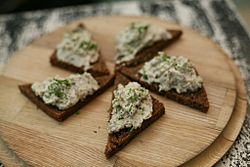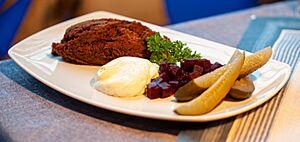Vorschmack facts for kids

Odessa Jewish-style vorschmack served on rye bread
|
|
| Course | Hors d'oeuvre |
|---|---|
| Region or state | Eastern Europe, Ashkenazi Jewish diaspora |
| Associated national cuisine | Ashkenazi Jewish, American Jewish, Finnish, German, Israeli, Ukrainian Jewish, Ukrainian, Polish, Russian |
| Main ingredients | Ground meat and/or fish |
Vorschmack or forshmak is a tasty dish that comes from Eastern Europe. Its name comes from an old German word meaning "foretaste" or "appetizer." This dish is usually made from salty minced (finely chopped) fish or meat.
You'll find different kinds of vorschmack, especially in Jewish and Finnish cooking. It's also popular in Ukrainian, Polish, and Russian food traditions. It can be served hot or cold, and it's often enjoyed as a starter before a main meal.
Contents
What is Jewish Vorschmack?
Many food experts believe vorschmack might have started in Germany. One expert, William Pokhlyobkin, says it was originally a hot appetizer from East Prussia. It was made from fried herring.
How Jewish People Changed the Dish
When Ashkenazi Jews (Jewish people from Central and Eastern Europe) adopted the dish, they changed it. They made it into a cold appetizer, like a pâté. This version uses chopped brined herring. In places like Ukraine, it became known as forshmak. However, Jewish people in Poland and Lithuania often called it gehakte herring, which means "chopped herring."
What's in Traditional Jewish Vorschmack?
Traditional recipes for Jewish vorschmack often include:
- Chopped hard-boiled eggs
- Onions
- Grated fresh apples
Sometimes, potatoes are added too. This appetizer is usually served as a salad. You can also spread it on bread, crackers, or special cookies called kichlach. Some people even eat it for breakfast or as a main meal with boiled potatoes.
Vorschmack in Russian Cooking
Today, many people in Russia think of vorschmack as a Jewish dish. But in the past, Russia had many different versions of it. These were usually hot appetizers called zakuski or breakfast dishes.
Old Russian Recipes
A famous Russian cookbook from 1861, A Gift to Young Housewives by Elena Molokhovets, had three recipes for hot vorschmack. Later editions added even more. One recipe used minced meat (like veal or beef), herring, white bread, and onions. These ingredients were mixed with smetana (sour cream) or cream and then baked. Other recipes used only herring, along with potatoes, eggs, and apples.
Another classic Russian cookbook from 1899, The Practical Fundamentals of the Cookery Art, gave even more detailed recipes. It suggested putting the chopped ingredients inside a kalach (a type of bread). Then, it was covered with grated cheese and baked until golden brown, a style called au gratin. Similar recipes also appeared in a big cookbook from 1955 about Soviet cuisine.
Vorschmack in Polish Cooking
In Polish cooking, forszmak (pronounced the same as vorschmack) can be a cold pâté or a hot baked appetizer. The recipes are quite similar to the Russian ones.
Forszmak Lubelski
There's another type of forszmak in eastern Poland, especially in the Lublin region. This one is a meat stew called forszmak lubelski. It's usually made with chopped meat (beef, pork, or chicken), pickled cucumbers, and tomato paste.
Vorschmack in Finnish Cooking
In Finnish cuisine, vorschmack is typically made from ground meat, anchovies or herring, and onions. This dish is often served with potatoes, pickles, and smetana (sour cream). People often drink Snaps (a type of alcoholic drink) with vorschmack. Some recipes even include cognac.
The Story of Finnish Vorschmack
There are many stories about how vorschmack became a traditional Finnish dish. It was a favorite appetizer of Marshall Gustaf Mannerheim. He was a very important Finnish president, statesman, and war hero. Some people say Mannerheim brought the dish to Finland from Poland or Russia. However, there isn't clear proof for these claims.
Where to Find Finnish Vorschmack
The Savoy restaurant in Helsinki, Finland, is famous for its vorschmack. Marshall Mannerheim often visited this restaurant. His favorite table at the Savoy was always kept reserved for him. Out of respect, no one else would ever ask to sit there. Today, the Savoy restaurant still looks and serves food much like it did in Mannerheim's time.
Images for kids
See also
 In Spanish: Vorschmack para niños
In Spanish: Vorschmack para niños






